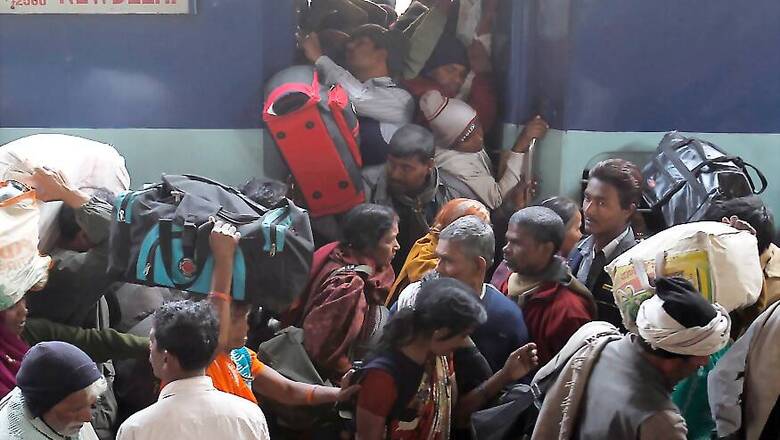
views
New Delhi: An Indian airline has reported that only 34% of its flights were on time in February from one crowded airport. That means two out of every three flights were delayed.
The Bar Council of India held its elections in Delhi a few days back and campaigning by lawyers threw traffic out of gear across the most important stretches of the Capital for several days. Just before that, a visit by foreign delegates for a conference on solar energy had tied up the Capital in knots.
The traffic woes of Mumbai, Bengaluru residents are now legendary. As for trains, this fiscal year has seen even the marquee ones fail to meet their schedules. The figures gleaned from official data, underline an infrastructure emergency, which is not getting addressed fast enough. Our Rail tracks, airports and roads are choked beyond capacity and there’s little relief in sight.
Infrastructure woes, technical snags, factors beyond control are standard responses given by airlines and the Railways for delays. These do not vary across the public and private sector players — our skies are predominantly populated by private airlines, along with state-owned Air India, whereas all our passenger trains are run by the Ministry of Railways.
Data presented in Lok Sabha last week showed that almost every third Rajdhani and every third Duronto was delayed between April 1, 2017 and March 10, 2018. Every sixth Shatabdi and almost every fourth Mail/ Express train was delayed too.
In fact, 451 Mail/ Express trains were delayed every day during this period. These significant delays across the Railways network were reported even when trains arriving 15 minutes after their scheduled time were not included in the list.
Of the 8,595 Rajdhanis that operated, 2,507 or 29.17% were delayed. From the 7,077 Durontos, 2,177 or 30.76% of the train services was delayed.
Every fourth Mail/ Express train and almost every sixth Shatabdi train was also delayed. Of 14,722 Shatabdis, 2524 or over 17% were delayed. Of 3,23,222 Mail/ Express trains, 78,502 or 24.29% were delayed.
Officials of the Ministry of Railways said that operating punctuality performance has improved by around 5% over the last three years but the terminating punctuality has been maintained at “almost the same level” despite increase in the number of trains.
In 2016-17, only 76.69% of terminating Mail/ Express trains were on time. That means almost every fourth service was delayed.
Remember, Railways is the country’s largest passenger transporter, ferrying more than 22 million people across its network each day. Such frequent delays mean loss of time and it surely has significant economic fallout as well.
In the Lok Sabha reply, MoS Railways Rajen Gohain said, “On an average, 451 Mail/ Express trains were delayed per day during current financial year due to various factors, some of which were beyond the control of Railways. However, some of these trains got consistently delayed largely on account of dense fog, large number of speed restrictions for ongoing track maintenance and infrastructure augmentation works over Indian Railways network.”
Now on to airlines. Last month, Mumbai airport was the biggest culprit in delays. While flights were earlier managing to arrive/ depart from Mumbai at about 50% on-time statistic, February saw one airline’s on-time performance plummet.
The latest DGCA data shows that this airline could manage only 34.5% flights on time from Mumbai – which means two in three flights were delayed. The record of all other airlines flying in and out of Mumbai was not much better – the best performance out of this choked airport was one airline at 48.9%. This means, at least every second flight landing or departing from Mumbai was delayed, whichever airline you chose to fly. The current Mumbai airport has been strained beyond capacity and plans to build a new one at Navi Mumbai have been horribly delayed.
Other major airports are not much better either, they are also getting overcrowded at the terminals as well as on the airside. Our domestic air traffic has been growing in double digits for many months now. Airport infrastructure, especially at the busiest ones like Mumbai and Delhi, has not been able to keep up. The government does speak of spending mega bucks on adding airport capacities in the future but also hints at how lakhs of crores needed for airport infrastructure will have to come from the private sector.
A recent report by AFP quoted global aviation consultancy CAPA saying that India has witnessed a six-fold increase in passenger numbers over the past decade. Indian airports handled 265 million domestic passengers in 2016 and will cross 300 million this year. But the country's entire airport network is only capable of handling 317 million passengers.
As for roads, another Lok Sabha reply shows that between 2005 to 2015, the number of registered vehicles increased at a Compound Annual Growth Rate (CAGR) of 9.8%, whereas the total road length in the country increased at a CAGR of 3.7%.
Delhi already has more vehicles than the other three major metros put together. Every second citizen in the Capital owns a vehicle, with 556 motor vehicles per 1,000 residents, according to the Economic Survey of Delhi for 2017-18. The total number of motor vehicles in Delhi was 1.03 crore as on March 31, 2017, up 6.99% from 2016-17. Is it any wonder then that with vehicle numbers zooming and increasing load from incoming vehicles from the NCR region and beyond, Delhi roads remain choked virtually throughout the day?
(The author is a senior journalist. Views are personal)















Comments
0 comment